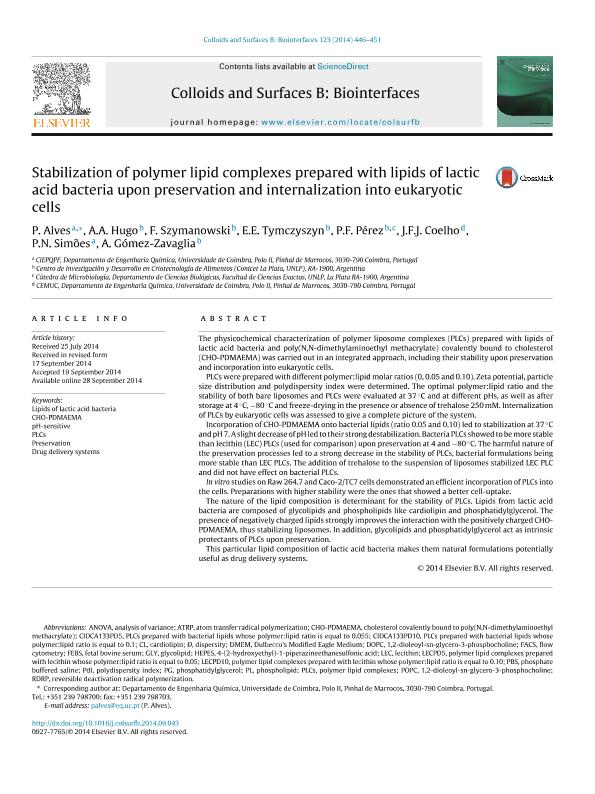Mostrar el registro sencillo del ítem
dc.contributor.author
Alves, P.A
dc.contributor.author
Hugo, Ayelen Amelia

dc.contributor.author
Szymanowski, Felipe

dc.contributor.author
Tymczyszyn, Emma Elizabeth

dc.contributor.author
Perez, Pablo Fernando

dc.contributor.author
Cohelo, J.F.J.
dc.contributor.author
Simoes, P.N
dc.contributor.author
Gomez Zavaglia, Andrea

dc.date.available
2018-01-12T19:41:39Z
dc.date.issued
2014-09
dc.identifier.citation
Simoes, P.N; Cohelo, J.F.J.; Perez, Pablo Fernando; Tymczyszyn, Emma Elizabeth; Szymanowski, Felipe; Hugo, Ayelen Amelia; et al.; Stabilization of polymer lipid complexes prepared with lipids of lactic acid bacteria upon preservation and internalization into eukaryotic cells; Elsevier Science; Colloids and Surfaces B: Biointerfaces; 123; 9-2014; 446-451
dc.identifier.issn
0927-7765
dc.identifier.uri
http://hdl.handle.net/11336/33145
dc.description.abstract
The physicochemical characterization of polymer liposome complexes (PLCs) prepared with lipids of lactic acid bacteria and poly(N,N-dimethylaminoethyl methacrylate) covalently bound to cholesterol (CHO-PDMAEMA) was carried out in an integrated approach, including their stability upon preservation and incorporation into eukaryotic cells. PLCs were prepared with different polymer:lipid molar ratios (0, 0.05 and 0.10). Zeta potential, particle size distribution and polydispersity index were determined. The optimal polymer:lipid ratio and the stability of both bare liposomes and PLCs were evaluated at 37 °C and at different pHs, as well as after storage at 4 °C, −80 °C and freeze-drying in the presence or absence of trehalose 250 mM. Internalization of PLCs by eukaryotic cells was assessed to give a complete picture of the system. Incorporation of CHO-PDMAEMA onto bacterial lipids (ratio 0.05 and 0.10) led to stabilization at 37 °C and pH 7. A slight decrease of pH led to their strong destabilization. Bacteria PLCs showed to be more stable than lecithin (LEC) PLCs (used for comparison) upon preservation at 4 and −80 °C. The harmful nature of the preservation processes led to a strong decrease in the stability of PLCs, bacterial formulations being more stable than LEC PLCs. The addition of trehalose to the suspension of liposomes stabilized LEC PLC and did not have effect on bacterial PLCs. In vitro studies on Raw 264.7 and Caco-2/TC7 cells demonstrated an efficient incorporation of PLCs into the cells. Preparations with higher stability were the ones that showed a better cell-uptake. The nature of the lipid composition is determinant for the stability of PLCs. Lipids from lactic acid bacteria are composed of glycolipids and phospholipids like cardiolipin and phosphatidylglycerol. The presence of negatively charged lipids strongly improves the interaction with the positively charged CHO-PDMAEMA, thus stabilizing liposomes. In addition, glycolipids and phosphatidylglycerol act as intrinsic protectants of PLCs upon preservation. This particular lipid composition of lactic acid bacteria makes them natural formulations potentially useful as drug delivery systems.
dc.format
application/pdf
dc.language.iso
eng
dc.publisher
Elsevier Science

dc.rights
info:eu-repo/semantics/openAccess
dc.rights.uri
https://creativecommons.org/licenses/by-nc-sa/2.5/ar/
dc.subject
Lipids of Lactic Acid Bacteria
dc.subject
Cho-Pdmaema
dc.subject
Ph-Sensitive
dc.subject
Plcs
dc.subject
Preservation
dc.subject
Drug Delivery Systems
dc.subject.classification
Alimentos y Bebidas

dc.subject.classification
Otras Ingenierías y Tecnologías

dc.subject.classification
INGENIERÍAS Y TECNOLOGÍAS

dc.title
Stabilization of polymer lipid complexes prepared with lipids of lactic acid bacteria upon preservation and internalization into eukaryotic cells
dc.type
info:eu-repo/semantics/article
dc.type
info:ar-repo/semantics/artículo
dc.type
info:eu-repo/semantics/publishedVersion
dc.date.updated
2018-01-12T16:32:08Z
dc.journal.volume
123
dc.journal.pagination
446-451
dc.journal.pais
Países Bajos

dc.journal.ciudad
Amsterdam
dc.description.fil
Fil: Alves, P.A. Universidad de Coimbra; Portugal
dc.description.fil
Fil: Hugo, Ayelen Amelia. Provincia de Buenos Aires. Gobernación. Comisión de Investigaciones Científicas. Centro de Investigación y Desarrollo en Criotecnología de Alimentos. Consejo Nacional de Investigaciones Científicas y Técnicas. Centro Científico Tecnológico Conicet - La Plata. Centro de Investigación y Desarrollo en Criotecnología de Alimentos. Universidad Nacional de La Plata. Facultad de Ciencias Exactas. Centro de Investigación y Desarrollo en Criotecnología de Alimentos; Argentina
dc.description.fil
Fil: Szymanowski, Felipe. Provincia de Buenos Aires. Gobernación. Comisión de Investigaciones Científicas. Centro de Investigación y Desarrollo en Criotecnología de Alimentos. Consejo Nacional de Investigaciones Científicas y Técnicas. Centro Científico Tecnológico Conicet - La Plata. Centro de Investigación y Desarrollo en Criotecnología de Alimentos. Universidad Nacional de La Plata. Facultad de Ciencias Exactas. Centro de Investigación y Desarrollo en Criotecnología de Alimentos; Argentina
dc.description.fil
Fil: Tymczyszyn, Emma Elizabeth. Provincia de Buenos Aires. Gobernación. Comisión de Investigaciones Científicas. Centro de Investigación y Desarrollo en Criotecnología de Alimentos. Consejo Nacional de Investigaciones Científicas y Técnicas. Centro Científico Tecnológico Conicet - La Plata. Centro de Investigación y Desarrollo en Criotecnología de Alimentos. Universidad Nacional de La Plata. Facultad de Ciencias Exactas. Centro de Investigación y Desarrollo en Criotecnología de Alimentos; Argentina
dc.description.fil
Fil: Perez, Pablo Fernando. Provincia de Buenos Aires. Gobernación. Comisión de Investigaciones Científicas. Centro de Investigación y Desarrollo en Criotecnología de Alimentos. Consejo Nacional de Investigaciones Científicas y Técnicas. Centro Científico Tecnológico Conicet - La Plata. Centro de Investigación y Desarrollo en Criotecnología de Alimentos. Universidad Nacional de La Plata. Facultad de Ciencias Exactas. Centro de Investigación y Desarrollo en Criotecnología de Alimentos; Argentina. Universidad Nacional de la Plata. Facultad de Ciencias Exactas. Departamento de Ciencias Biológicas. Cátedra de Microbiología General; Argentina
dc.description.fil
Fil: Cohelo, J.F.J.. Universidad de Coimbra; Portugal
dc.description.fil
Fil: Simoes, P.N. Universidad de Coimbra; Portugal
dc.description.fil
Fil: Gomez Zavaglia, Andrea. Provincia de Buenos Aires. Gobernación. Comisión de Investigaciones Científicas. Centro de Investigación y Desarrollo en Criotecnología de Alimentos. Consejo Nacional de Investigaciones Científicas y Técnicas. Centro Científico Tecnológico Conicet - La Plata. Centro de Investigación y Desarrollo en Criotecnología de Alimentos. Universidad Nacional de La Plata. Facultad de Ciencias Exactas. Centro de Investigación y Desarrollo en Criotecnología de Alimentos; Argentina
dc.journal.title
Colloids and Surfaces B: Biointerfaces

dc.relation.alternativeid
info:eu-repo/semantics/altIdentifier/doi/http://dx.doi.org/10.1016/j.colsurfb.2014.09.043
dc.relation.alternativeid
info:eu-repo/semantics/altIdentifier/url/http://www.sciencedirect.com/science/article/pii/S0927776514005141
Archivos asociados
